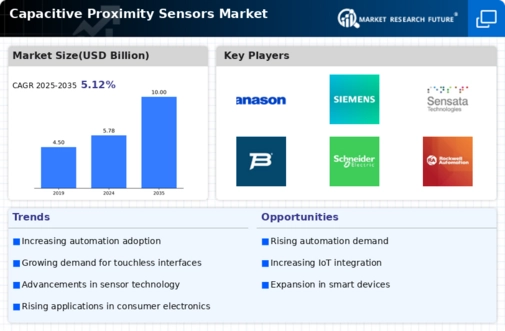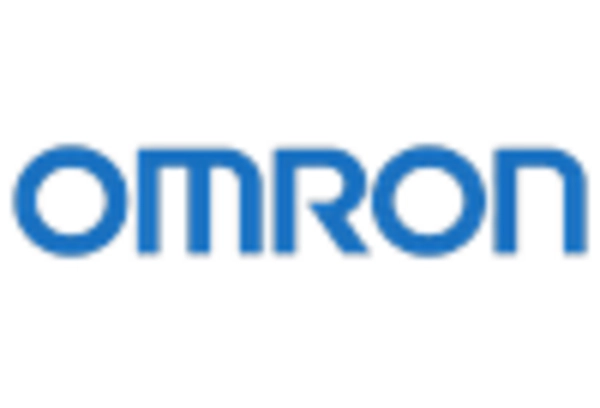Focus on Energy Efficiency
The Capacitive Proximity Sensors Market is also driven by a growing emphasis on energy efficiency and sustainability. As industries and consumers alike become more environmentally conscious, there is a push for technologies that minimize energy consumption. Capacitive sensors, known for their low power requirements, are increasingly favored in applications where energy efficiency is paramount. This trend is particularly evident in sectors such as building automation and smart grids, where energy savings can lead to significant cost reductions. The market for energy-efficient technologies is expected to expand, potentially reaching a valuation of 500 billion by 2027, thereby enhancing the prospects for the Capacitive Proximity Sensors Market.
Expansion in Emerging Markets
The Capacitive Proximity Sensors Market is witnessing growth due to the expansion of emerging markets. Countries in Asia-Pacific and Latin America are experiencing rapid industrialization and urbanization, leading to increased demand for automation and advanced sensing technologies. As these regions invest in infrastructure and manufacturing capabilities, the need for reliable and efficient sensors becomes more pronounced. Market analysts project that the Asia-Pacific region alone could account for over 40% of The Capacitive Proximity Sensors Market by 2026. This expansion presents a significant opportunity for the Capacitive Proximity Sensors Market, as manufacturers seek to capitalize on the growing demand in these developing economies.
Rising Demand for Smart Devices
The proliferation of smart devices is a key driver for the Capacitive Proximity Sensors Market. As consumers increasingly seek advanced functionalities in their electronic devices, manufacturers are incorporating capacitive sensors to enhance user experience. These sensors enable features such as touchless operation and gesture recognition, which are becoming standard in smartphones, tablets, and home automation systems. The market for smart devices is projected to grow significantly, with estimates suggesting a potential increase to over 1 trillion by 2025. This growth is likely to create substantial opportunities for the Capacitive Proximity Sensors Market, as more devices require sophisticated sensing technologies to meet consumer expectations.
Increasing Adoption in Industrial Automation
The Capacitive Proximity Sensors Market is significantly influenced by the increasing adoption of automation technologies across various sectors. Industries such as manufacturing, automotive, and packaging are integrating capacitive sensors into their processes to improve efficiency and reduce operational costs. The ability of these sensors to detect non-metallic objects without direct contact makes them ideal for applications in automated assembly lines and robotic systems. According to recent estimates, the industrial automation sector is expected to reach a valuation of over 200 billion by 2026, further propelling the demand for capacitive proximity sensors. This trend suggests that as industries continue to embrace automation, the Capacitive Proximity Sensors Market will likely expand in tandem.
Technological Advancements in Sensor Technology
The Capacitive Proximity Sensors Market is experiencing a surge in technological advancements that enhance sensor performance and reliability. Innovations such as improved signal processing algorithms and miniaturization of components are driving the development of more efficient sensors. These advancements allow for greater sensitivity and accuracy in detecting objects, which is crucial in various applications, including industrial automation and consumer electronics. The market is projected to grow at a compound annual growth rate (CAGR) of approximately 8% over the next five years, indicating a robust demand for advanced sensor solutions. As manufacturers continue to invest in research and development, the Capacitive Proximity Sensors Market is likely to witness the introduction of next-generation sensors that offer enhanced features and capabilities.
















Leave a Comment